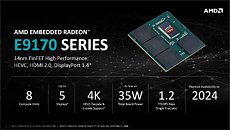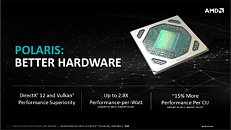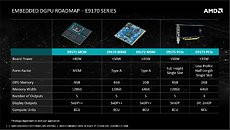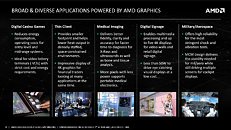Tuesday, October 3rd 2017

AMD Announces New Radeon Embedded GPUs
AMD today announced the AMD Embedded Radeon E9170 Series graphics processing unit (GPU). The new processor is the first "Polaris" architecture-based AMD Embedded discrete GPU available in multi-chip module (MCM) format with integrated memory for smaller, power-efficient custom designs, as well as PCI Express and MXM formats for standard form factor systems. The E9170 Series GPU is ideal for devices that require premium graphics and expanded display capabilities while meeting exacting power and thermal efficiency demands. AMD is extending its core graphics technology, delivering crystal clear resolution and a stunning and seamless 4K experience across multiple displays to a growing number of markets, including digital casino games, thin clients, medical displays, retail and digital signage, and industrial systems.
The AMD Embedded Radeon E9173 GPU, based on the "Polaris" architecture, leverages an optimized 14nm FinFET manufacturing process to provide up to 3X the performance-per-watt over previous generations of AMD Embedded GPUsi. By offering sub-40W TDP in a small package, AMD enables a broader range of products, adding a new level of scalability to the AMD Radeon Power-Efficient Embedded GPU portfolio. With support for up to five simultaneous 4K displaysii, the E9170 Series GPU virtually eliminates the need for additional processors and duplicate hardware to create an immersive multimedia environment. Additionally, the option to select from MCM, MXM and PCI Express modules increases design flexibility while minimizing complexity."Developers are continuing to push the boundaries on what's possible for embedded systems, demanding more performance, more features and more design options, all while significantly reducing power consumption. At the GPU level, it is critical to provide versatile solutions that do not compromise on graphics performance or 4K multi-display capabilities," said Colin Cureton, director of product management, AMD Enterprise Solutions. "The new AMD Embedded Radeon E9170 Series GPU not only achieves up to 3X the performance-per-watt over previous solutions, but is the first 'Polaris'-based Embedded GPU available in the MCM form factor to enable sleek designs in a variety of sizes, striking the optimal balance of performance and power efficiency."
Key Application Benefits of the E9170 Series
Quixant
"Quixant is a long-term AMD partner and we have successfully implemented several generations of high-performance GPUs for various casino gaming systems," said Nick Jarmany, Chief Executive Officer, Quixant. "The new AMD Radeon GPU in the MCM form factor provides us with the competitive performance advantage we expect from AMD, while also driving down power consumption so we can deliver advanced, eye-catching content on a 4K display in a compact, cost-effective package, keeping our customers at the top of their game."
Eizo
"Over the last 10 years, Eizo Rugged Solutions has partnered with AMD Embedded to successfully bring highly reliable and rugged graphics, video capture and encoding products to several large defense programs," said Selwyn L Henriques, President and Chief Executive Officer, Eizo Rugged Solutions. "AMD's unwavering commitment to the embedded market, including long product lifecycles and GPUs with high performance-per-watt, has enabled us to offer our customers exceptional video solutions that meet or exceed their needs and minimize TCO. The new Eizo XMC and 3U VPX products, based on the AMD Embedded Radeon E9170 Series GPU, will help us deliver even higher performance and continue to expand our customer base."
Availability
The AMD Embedded Radeon E9170 Series GPU in PCI Express and MXM module configurations are planned to be available in October 2017, and the E9170 Series GPU MCM module configuration is planned for November 2017.
The AMD Embedded Radeon E9173 GPU, based on the "Polaris" architecture, leverages an optimized 14nm FinFET manufacturing process to provide up to 3X the performance-per-watt over previous generations of AMD Embedded GPUsi. By offering sub-40W TDP in a small package, AMD enables a broader range of products, adding a new level of scalability to the AMD Radeon Power-Efficient Embedded GPU portfolio. With support for up to five simultaneous 4K displaysii, the E9170 Series GPU virtually eliminates the need for additional processors and duplicate hardware to create an immersive multimedia environment. Additionally, the option to select from MCM, MXM and PCI Express modules increases design flexibility while minimizing complexity."Developers are continuing to push the boundaries on what's possible for embedded systems, demanding more performance, more features and more design options, all while significantly reducing power consumption. At the GPU level, it is critical to provide versatile solutions that do not compromise on graphics performance or 4K multi-display capabilities," said Colin Cureton, director of product management, AMD Enterprise Solutions. "The new AMD Embedded Radeon E9170 Series GPU not only achieves up to 3X the performance-per-watt over previous solutions, but is the first 'Polaris'-based Embedded GPU available in the MCM form factor to enable sleek designs in a variety of sizes, striking the optimal balance of performance and power efficiency."
Key Application Benefits of the E9170 Series
- Digital casino games: Helping reduce energy consumption and operating costs, the E9170 Series GPU cuts down on operating costs for entry level and midrange casino gaming systems, as well as lowers thermal dissipation that impacts facility air conditioning costs. Support for five independent and simultaneous displays allows companies to create an eye-catching experience with more pixels and more action. DirectX 12 support enables higher frames per second and reduced latency, and cross-platform Vulkan API support helps ensure better image quality while decreasing CPU processing bottlenecks.
- Thin clients: Thin clients powered by the E9170 Series GPU can have a smaller hardware footprint than traditional PC systems, and can have lower heat output and provide cooler workspaces in densely-staffed and space-constrained environments such as stock exchange trading floors. Additionally, 4K graphics resolution provides crisp visual clarity when thin clients are in split-screen display mode, improving the end-user experience.
- Medical displays: The high-performance 4K graphics resolution in the E9170 Series GPU helps improve the accuracy of clinical diagnoses in X-Ray machines and ultrasounds as well as with bone tissue and analysis, helping medical professionals to enhance patient care.
- Retail and digital signage: Cost-conscious signage companies integrating the E9170 Series GPU can drive up to five simultaneous 4K displays for a stunning visual experience that holds viewer attention without incurring a premium processor price.
- Industrial: The Radeon E9170 Series GPU in the reliable MCM format enables the stability required for the most stringent shock and vibration tests in environments such as airplane cockpits, in addition to driving multiple displays.
- Up to 1.25 TFLOPS at sub-40W TDP board power, setting a new benchmark within the AMD Radeon Power-Efficient Embedded GPU portfolio by delivering up to 3X the performance-per-watt over previous generations.
- 4K optimization and flexible multi-display configurability to enable rich multimedia and design versatility.
- Features include 4K HEVC/H.265iii and AVC/H.264 decode and encode, and up to five display outputs using HDMI 2.0 and/or DisplayPort 1.4.
- Available in compact MCM, standard MXM and PCI Express card form factors.
- Planned availability through 2024 to ensure support continuity for long-lifecycle products and next-generation designs.
- 4K and 3D support ensures unparalleled visual immersion.
- 4GB memory (128bit GDDR5) for high-performance needs.
Quixant
"Quixant is a long-term AMD partner and we have successfully implemented several generations of high-performance GPUs for various casino gaming systems," said Nick Jarmany, Chief Executive Officer, Quixant. "The new AMD Radeon GPU in the MCM form factor provides us with the competitive performance advantage we expect from AMD, while also driving down power consumption so we can deliver advanced, eye-catching content on a 4K display in a compact, cost-effective package, keeping our customers at the top of their game."
Eizo
"Over the last 10 years, Eizo Rugged Solutions has partnered with AMD Embedded to successfully bring highly reliable and rugged graphics, video capture and encoding products to several large defense programs," said Selwyn L Henriques, President and Chief Executive Officer, Eizo Rugged Solutions. "AMD's unwavering commitment to the embedded market, including long product lifecycles and GPUs with high performance-per-watt, has enabled us to offer our customers exceptional video solutions that meet or exceed their needs and minimize TCO. The new Eizo XMC and 3U VPX products, based on the AMD Embedded Radeon E9170 Series GPU, will help us deliver even higher performance and continue to expand our customer base."
Availability
The AMD Embedded Radeon E9170 Series GPU in PCI Express and MXM module configurations are planned to be available in October 2017, and the E9170 Series GPU MCM module configuration is planned for November 2017.




52 Comments on AMD Announces New Radeon Embedded GPUs
GCN has survived thanks to price cuts. Vega is a good example of a tired design, it's tuned way past it's efficiency to try and stay relevant.
If forza 6 is any indication then vega has alot of potential. And if we follow historical trends then vega 64 will be trading blows in benchmarks with gtx1080ti once fully optimized probably in a year or so
Look at Vega vs Fury IPC comparisons, GCN hasn't evolved very well. Check a review of an A12 9700 and compare it to previous APUs (that's Polaris vs GCN1.1 and 1.2), even DDR4 doesn't make a big jump to those 8CUs.
b) We should wait a few months or even years before making assumptions on the true performance of Vega / its IPC, it's simply too early to tell - examples such as Forza 7 are a good example why I say this.
llvm.org/docs/AMDGPUUsage.html
AMD won't just simply add compatibility to Vega in LLVM if it was a different arch. Same story with the drivers, both radeonsi and AMDGPU are GCN exclusive drivers, you have something new, you need new drivers.
It's a different architecture but not completely. Same as the difference between Sandy Bridge and Haswell or Haswell and Skylake. It's a bigger difference, but nothing entirely new.
Weir thing is, on a driver level Fiji seems the same as Polaris.
R9 290 or Hawaii is GCN 1.1 or 2nd Gen
390 same.
380 or 285 is GCN 1.2 or 3rd Gen
480/580 or Polaris is GCN 1.3, true, or 4th Gen
There is no "1.4" because Vega is GCN 2.0 by that logic. Either that or 500 series is 1.4 because they slightly refined it, making higher clocks possible. Anyway, I call them by their true names given by AMD, that is GCN Gen 1/2/3/4/5.
GCN1.0 still is a GCN product, like Vega. A 8CU (512 shaders) Polaris is pretty much the same as an old HD7750, if not weaker if they don't use a 512/32/16 layout.
As I said, check if the new AM4 APUs are any better than the old FM2+ ones, IPC hasn't changed in recent years in GCN, only the clock frequency/power consumption balance thanks to refinements and process reduction.
You want a real change in design and performance that is not only visible in compute work? Do what GCN did to Terascale, or Maxwell to Kepler.
Did someone test if the performance of Vega in Forza is not also visible on a Fury X?
Let's just stop spamming this thread with the same thing over and over.
Aint nobody but fanbois got time to wait that long for AMD to perform.
IPC has in fact increased, there are reviews on the net, if you don't believe me. But please research yourself I'm not here to do your homework and as I see it you have a lot of work to do and I won't do it for you.I concur to that though. It is true that AMD lacks a proper gaming engine without compute nonsense gamers 99% don't need anyway. Vega / Fury X etc. are not gaming engines, they are all multi purpose engines comparable to Kepler/Fermi/Tesla but not to Maxwell or Pascal (consumer variant). On top of that it's obvious Fury X and also Vega lack ROPs, 64 aren't enough, it's also the reason why after 1440p the card is falling in performance whereas the 1080 Ti is still rising. Reminder: Hawaii also had 64 ROPs, a GPU with a lot less shaders 2816 compared to 4096 each. The design of Fiji / Vega is simply not balanced.Fury X was included in the same test and also had very high performance rivaling that of GTX 1070 which represents a overclocked GTX 980 Ti - suffice to say, Fury X normally had no chance against a overclocked 980 Ti.
Why do you treat them different is something I don't understand, you don't call the i7 7700K an AVX processor, it IS an x86 one.
You compile a program with LLVM for GCN and it works in an A8 7600, a HD7730, and a Vega 56. "It's not GCN" is marketing, not reality.